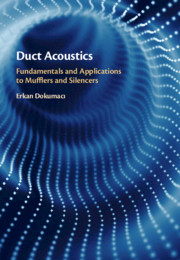Refine search
Actions for selected content:
8126 results in Fluid dynamics and solid mechanics
3 - Transmission of Low-Frequency Sound Waves in Ducts
-
- Book:
- Duct Acoustics
- Published online:
- 11 May 2021
- Print publication:
- 13 May 2021, pp 59-124
-
- Chapter
- Export citation
11 - Radiated Sound Pressure Prediction
-
- Book:
- Duct Acoustics
- Published online:
- 11 May 2021
- Print publication:
- 13 May 2021, pp 474-500
-
- Chapter
- Export citation
1 - Some Preliminaries
-
- Book:
- Duct Acoustics
- Published online:
- 11 May 2021
- Print publication:
- 13 May 2021, pp 1-22
-
- Chapter
-
- You have access
- HTML
- Export citation
9 - Reflection and Radiation at Open Duct Terminations
-
- Book:
- Duct Acoustics
- Published online:
- 11 May 2021
- Print publication:
- 13 May 2021, pp 399-437
-
- Chapter
- Export citation
8 - Effects of Viscosity and Thermal Conductivity
-
- Book:
- Duct Acoustics
- Published online:
- 11 May 2021
- Print publication:
- 13 May 2021, pp 369-398
-
- Chapter
- Export citation
7 - Transmission of Wave Modes in Coupled Ducts
-
- Book:
- Duct Acoustics
- Published online:
- 11 May 2021
- Print publication:
- 13 May 2021, pp 326-368
-
- Chapter
- Export citation
Preface
-
- Book:
- Duct Acoustics
- Published online:
- 11 May 2021
- Print publication:
- 13 May 2021, pp xvii-xx
-
- Chapter
- Export citation
4 - Transmission of One-Dimensional Waves in Coupled Ducts
-
- Book:
- Duct Acoustics
- Published online:
- 11 May 2021
- Print publication:
- 13 May 2021, pp 125-172
-
- Chapter
- Export citation
Dedication
-
- Book:
- Duct Acoustics
- Published online:
- 11 May 2021
- Print publication:
- 13 May 2021, pp v-vi
-
- Chapter
- Export citation
Index
-
- Book:
- Duct Acoustics
- Published online:
- 11 May 2021
- Print publication:
- 13 May 2021, pp 579-586
-
- Chapter
- Export citation

Duct Acoustics
- Fundamentals and Applications to Mufflers and Silencers
-
- Published online:
- 11 May 2021
- Print publication:
- 13 May 2021
SLOW-BURNING INSTABILITIES OF DUFORT–FRANKEL FINITE DIFFERENCING
- Part of
-
- Journal:
- The ANZIAM Journal / Volume 63 / Issue 1 / January 2021
- Published online by Cambridge University Press:
- 30 April 2021, pp. 23-38
-
- Article
- Export citation
EFFICIENT COMPUTATION OF COORDINATE-FREE MODELS OF FLAME FRONTS
- Part of
-
- Journal:
- The ANZIAM Journal / Volume 63 / Issue 1 / January 2021
- Published online by Cambridge University Press:
- 29 April 2021, pp. 58-69
-
- Article
- Export citation
Index
-
- Book:
- Modern Impact and Penetration Mechanics
- Published online:
- 01 April 2021
- Print publication:
- 22 April 2021, pp 675-680
-
- Chapter
- Export citation
Appendix B - Units, Conversions, and Constants
-
- Book:
- Modern Impact and Penetration Mechanics
- Published online:
- 01 April 2021
- Print publication:
- 22 April 2021, pp 651-652
-
- Chapter
- Export citation
5 - Elastic-Plastic Deformation and Shocks
-
- Book:
- Modern Impact and Penetration Mechanics
- Published online:
- 01 April 2021
- Print publication:
- 22 April 2021, pp 175-256
-
- Chapter
- Export citation
4 - Mechanical Waves, Shocks, and Rarefactions
-
- Book:
- Modern Impact and Penetration Mechanics
- Published online:
- 01 April 2021
- Print publication:
- 22 April 2021, pp 117-174
-
- Chapter
- Export citation
12 - Nondeforming (Rigid) Impactors
-
- Book:
- Modern Impact and Penetration Mechanics
- Published online:
- 01 April 2021
- Print publication:
- 22 April 2021, pp 481-506
-
- Chapter
- Export citation
11 - Finite Targets
-
- Book:
- Modern Impact and Penetration Mechanics
- Published online:
- 01 April 2021
- Print publication:
- 22 April 2021, pp 443-480
-
- Chapter
- Export citation
Appendix D - Figure Acknowledgments
-
- Book:
- Modern Impact and Penetration Mechanics
- Published online:
- 01 April 2021
- Print publication:
- 22 April 2021, pp 663-664
-
- Chapter
- Export citation
